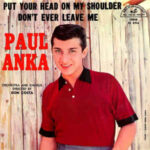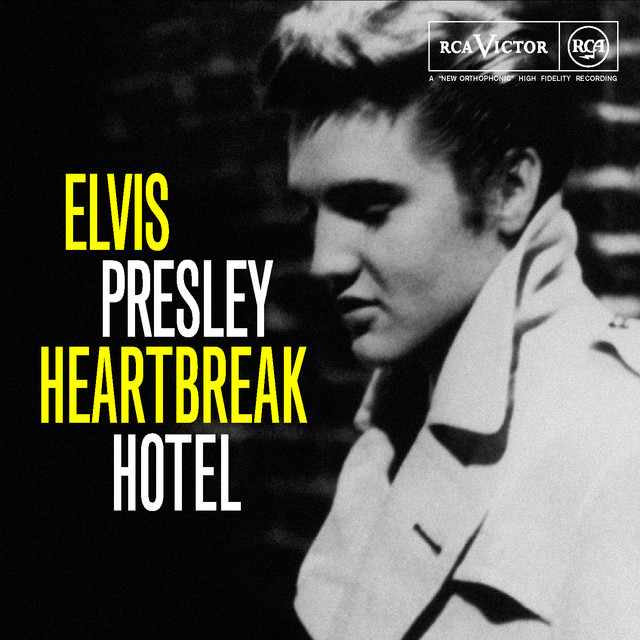 Long before pop music became obsessed with spectacle, synthesizers, and shock value, it was driven by something much simpler: emotion. A great melody, a heartfelt lyric, and a voice that made you believe every word. In 1959, Paul Anka—then just a teenager with an old soul—captured that spirit better than almost anyone with his iconic ballad “Put Your Head on My Shoulder.”
Long before pop music became obsessed with spectacle, synthesizers, and shock value, it was driven by something much simpler: emotion. A great melody, a heartfelt lyric, and a voice that made you believe every word. In 1959, Paul Anka—then just a teenager with an old soul—captured that spirit better than almost anyone with his iconic ballad “Put Your Head on My Shoulder.”
Released when Eisenhower was still in office and drive-ins ruled Friday nights, the song became an anthem for innocence and longing. It’s one of those rare records that instantly transports you to another time—a time of soda shops, letterman jackets, and slow dances in gymnasiums lit by paper lanterns. But “Put Your Head on My Shoulder” isn’t just a nostalgic artifact—it’s a masterclass in songwriting, emotional restraint, and romantic sincerity.
A Voice Beyond His Years
By the time Paul Anka recorded “Put Your Head on My Shoulder,” he was already a star. His first major hit, “Diana,” had topped the charts two years earlier, establishing him as a teen idol before he could legally vote. But while “Diana” was bright and upbeat, “Put Your Head on My Shoulder” was different. It wasn’t about infatuation—it was about intimacy.
Anka was only 17 when he wrote it, yet the song feels like it was crafted by someone decades older, someone who understood the quiet moments between words—the unspoken connection that happens when two people simply exist together. His voice glides effortlessly through the melody, tender but confident, soothing but yearning.
When he sings, “Hold me in your arms, baby / Squeeze me, oh, so tight,” it’s not lustful—it’s pure affection. He’s not trying to seduce; he’s trying to connect. That distinction is what made the song so revolutionary in its simplicity. It was sensual without being overt, romantic without being saccharine.
The Anatomy of a Classic
“Put Your Head on My Shoulder” is deceptively simple. It’s built around a gentle 6/8 rhythm, the kind of sway that mimics the motion of slow dancing or rocking in someone’s arms. The piano chords are lush but unintrusive, while the background vocals hum like a soft breeze.
The production—handled with classic late-’50s precision—is minimal yet evocative. Every instrument serves the emotion of the song, not the other way around. There’s no unnecessary ornamentation, no flash. Just space. That space is what gives Anka’s voice room to breathe, to draw you in closer.
And that melody—smooth, deliberate, heartbreakingly sweet—feels eternal. It’s the kind of melody that seems like it’s always existed, floating somewhere in the ether, waiting for someone like Anka to pluck it down and give it form.
The structure is pure pop craftsmanship: verse, chorus, verse, bridge, return. But what makes it special is how it never feels mechanical. The melody unfolds naturally, like a conversation whispered late at night.
When the key change hits toward the end, it’s subtle but deeply emotional—it feels like the moment when affection turns to confession, when you finally admit that what you’re feeling is love.
Love in the Age of Innocence
To understand why “Put Your Head on My Shoulder” resonated so deeply in 1959, you have to picture the world it emerged from. America was on the cusp of massive cultural change—rock ’n’ roll had broken the postwar mold, but the sexual revolution and counterculture were still years away.
This was an era of teenage longing constrained by social boundaries. Dating was ritualized, public displays of affection were modest, and love songs were the emotional outlet for everything people couldn’t say outright.
Anka’s song provided a soundtrack for that emotional landscape. It captured the magic of quiet intimacy, the kind that happens when words fall away and connection speaks for itself.
In that sense, “Put Your Head on My Shoulder” was more than a pop hit—it was emotional permission. It told a generation of young listeners that tenderness wasn’t weakness, that vulnerability could be beautiful.
And the brilliance is that Anka didn’t write it as a calculated hit. He later explained that he was simply observing the way young couples interacted—how they leaned close, whispered, shared moments of quiet affection. He wrote from observation and instinct, not marketing. That’s probably why it still feels authentic today.
The Cultural Footprint
Upon release, “Put Your Head on My Shoulder” became an instant hit, climbing to No. 2 on the Billboard Hot 100 and cementing Paul Anka’s status as one of the era’s defining voices. But its impact extended far beyond the charts.
It became the slow dance song of its generation. For countless teenagers in the late ’50s and early ’60s, it was the soundtrack to their first kiss, their first heartbreak, their first brush with real emotion.
And it never went away. The song has been covered by dozens of artists across decades—from The Lettermen’s lush harmony-driven version in the ’60s to Michael Bublé’s silky modern update. Even in the digital age, the song found new life: it became a viral TikTok trend in 2021 when it was remixed into a dreamy lo-fi duet with Doja Cat, introducing it to an entirely new audience.
That’s the true measure of a classic—it reinvents itself without losing its soul.
The Genius of Simplicity
Part of what makes “Put Your Head on My Shoulder” endure is how effortlessly it conveys emotion. In modern pop, production often does the heavy lifting—layers of sound designed to make you feel something. But here, the feeling comes from space, from the pauses, from the way Anka’s voice lingers on certain syllables.
Listen closely to the way he sings “maybe you love me”—the slight hesitation before “love” gives the line a fragile authenticity. You can almost hear the nervous energy of young love, the vulnerability that makes it both thrilling and terrifying.
That’s the magic of Paul Anka’s songwriting. He understood that the power of a song lies not in its complexity, but in its honesty. He wrote for the listener’s heart, not their intellect.
The Soundtrack of Romance
It’s easy to imagine “Put Your Head on My Shoulder” playing on a jukebox in a 1959 diner—chrome counters gleaming, neon lights flickering, a couple slow dancing near the corner booth while milkshakes sit unfinished. But it’s just as easy to picture it in a modern setting—a candlelit dinner, a wedding, a quiet moment shared between two people decades into a relationship.
That’s what separates a hit from a standard. A hit captures a moment. A standard captures a feeling that never expires.
For all its simplicity, “Put Your Head on My Shoulder” has a cinematic quality. It’s a three-minute movie about connection—no special effects, no dialogue, just emotion rendered in melody.
And because of that universality, it’s been used in countless films and TV shows to evoke nostalgia and sincerity: from Mad Men to Futurama to Scrubs. Anytime a director wants to convey the purity of old-fashioned love, Anka’s voice is there, softly guiding the scene.
Anka’s Evolution and Legacy
“Put Your Head on My Shoulder” wasn’t the end of Paul Anka’s story—it was the beginning of a remarkable career that spanned genres and generations. After dominating the teen idol scene of the late ’50s and early ’60s, Anka reinvented himself as one of pop’s most sophisticated songwriters.
He penned “My Way” for Frank Sinatra—arguably one of the most famous songs in history—and co-wrote the theme for The Tonight Show Starring Johnny Carson. He transitioned from teen sensation to adult contemporary icon without losing credibility, a feat very few artists manage.
But no matter how far he evolved, “Put Your Head on My Shoulder” remained his emotional signature. It was the song that first showcased his gift for melody and mood, his ability to translate universal emotion into three-minute poetry.
Why It Still Works Today
The world has changed drastically since 1959. Love songs today are often cynical, digital, self-aware. Yet “Put Your Head on My Shoulder” still feels genuine. Why? Because the fundamental human desire it expresses hasn’t changed.
At its core, it’s not about romance—it’s about comfort. About safety. About finding a small moment of peace in someone else’s presence. It’s the same emotion that makes modern songs like Ed Sheeran’s “Perfect” or Adele’s “Make You Feel My Love” resonate. The context evolves, but the feeling is eternal.
You can play it for someone who’s 80 or someone who’s 18, and it will still hit. The melody bypasses logic and lands directly in the heart. It’s the musical equivalent of a soft blanket on a cold night—warm, familiar, and deeply human.
The Quiet Power of Nostalgia
There’s a reason people keep returning to songs like “Put Your Head on My Shoulder.” It’s not just nostalgia—it’s a longing for simplicity. For a time when love didn’t have to be ironic or complex.
Listening to it now feels almost meditative. It slows your pulse. It reminds you that tenderness doesn’t have to be dramatic. It can exist in quiet gestures—a head resting on a shoulder, a whispered reassurance, a shared silence.
And maybe that’s what makes it such a perfect song for all eras. It doesn’t preach or posture. It just exists—gentle, graceful, timeless.
Final Thoughts
Paul Anka’s “Put Your Head on My Shoulder” is more than a song—it’s an experience. It captures the purity of young love, the comfort of closeness, and the beauty of emotional simplicity. Written by a teenager in 1959, it has transcended generations, genres, and technologies without losing an ounce of its charm.
It’s a testament to the idea that sincerity never goes out of style. In an age of overproduced love songs, Anka’s melody remains a quiet whisper of something we all still crave: connection without pretense.
As long as people fall in love—and need a song to capture that feeling—Paul Anka’s voice will keep echoing softly through time, offering the same simple invitation it always has:
“Put your head on my shoulder / Whisper in my ear, baby / Words I want to hear, tell me…”
Over six decades later, we’re still listening.


